BY LETTER
New Mars
Galactography > Regions of Space > Inner Sphere
Galactography > Sephirotic Empires > Non-Coercive Zone (NoCoZo)
Galactography > Systems and Worlds > Systems & Worlds M - N
Galactography > Sephirotic Empires > Non-Coercive Zone (NoCoZo)
Galactography > Systems and Worlds > Systems & Worlds M - N
Double star system, home to a number of diverse cultures | |
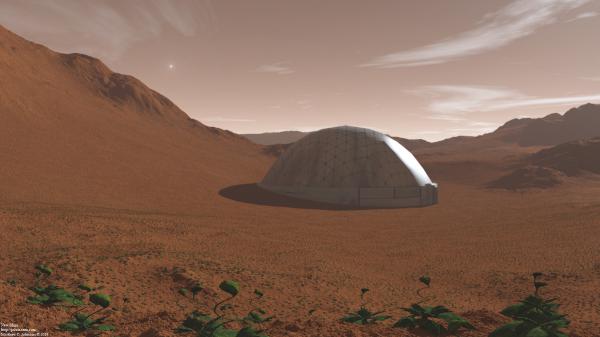 Image from Matthew C. Johnson | |
| The planet Olivine has been extensively remodelled to resemble the planet of Mars in the Old Solar System, as it existed before terraformation. Here are a number of dome habitats on the surface, with a small stand of Turbine plants in the foreground | |
Data Panel = New Mars (36 Ursae Majoris) | |
| System | Name: New Mars Component stars: 2 1) Maronyo (36 Ursae Majoris A) 2) Duminine (36 Ursae Majoris B) Separation: 1600 AU Location: - Distance from Sol: 42.22 ly (J2000) - Constellation: Ursa Major |
|---|---|
| Maronyo System | Names: Maronyo, 36 Ursae Majoris A, Gliese 395 (GJ 395), HD 90839, HIP 51459, HR 4112 Physical characteristics: - Mass: 1.049 x Sol - Radius: 1.180 x Sol - Temperature: 6,102 Kelvin - Luminosity: 1.739 x Sol (bolometric) - Spectral type: F8 V - Age: 2.23 billion years System: All planets in this system were named after characters in the Interplanetary Age Martian virch Rust and Olivine, created by the famous and influential fabulist Maronyo. 1) Glowing Flow, Glowing Sky: Black Hole Suprashell; Videntian Terrestrial LapiEdelian Gaian Genesian (artificial planet) Semi-major axis = 0.332 AU, Orbital period = 68.22 days, Eccentricity = 0.102, Mass = 0.053 x Earth, Radius = 0.400 x Earth 2) Lem: Videntian HydroTerrestrial LapiRhean CapnoCytherean Semi-major axis = 0.540 AU, Orbital period = 141.5 days, Eccentricity = 0.064, Mass = 2.279 x Earth, Radius = 1.270 x Earth 3) Asukara: AmmoTerrestrial LapiRhean PelaTundral CapnoGaian Semi-major axis = 0.767 AU, Orbital period = 239.5 days, Eccentricity = 0.122, Mass = 1.574 x Earth, Radius = 1.124 x Earth 4) Eskarett: Terrestrial LapiMinervan Agonian Semi-major axis = 1.128 AU, Orbital period = 1.170 years, Eccentricity = 0.066, Mass = 0.362 x Earth, Radius = 0.737 x Earth 5) Olivine: Terrestrial LapiMinervan CapnoArean HydroCryptian Semi-major axis = 1.464 AU, Orbital period = 1.730 years, Eccentricity = 0.105, Mass = 0.403 x Earth, Radius = 0.756 x Earth 6) Rust: HydroTerrestrial LapiRhean LacuTundral AquaGaian Semi-major axis = 1.891 AU, Orbital period = 2.539 years, Eccentricity = 0.147, Mass = 0.124 x Earth, Radius = 0.542 x Earth - Perfect Memories: Six orbital bands consisting of computronium habitats. Semi-major axis: 39.46 AU, Eccentricity = 0.135 ----------------------- (before colonization) 1) Glowspeck: Videntian Terrestrial LapiMinervan Achlysian Semi-major axis = 0.332 AU, Orbital period = 68.22 days, Eccentricity = 0.102, Mass = 0.053 x Earth, Radius = 0.400 x Earth 2) Lem: Videntian AcidiTerrestrial LapiRhean CapnoCytherean Semi-major axis = 0.540 AU, Orbital period = 141.5 days, Eccentricity = 0.064, Mass = 2.279 x Earth, Radius = 1.270 x Earth 3) Asukara: AcidiTerrestrial LapiMinervan CapnoCytherean Semi-major axis = 0.767 AU, Orbital period = 239.5 days, Eccentricity = 0.122, Mass = 1.574 x Earth, Radius = 1.124 x Earth 4) Eskarett: Terrestrial LapiMinervan Agonian Semi-major axis = 1.128 AU, Orbital period = 1.170 years, Eccentricity = 0.066, Mass = 0.362 x Earth, Radius = 0.737 x Earth 5) Olivine: Terrestrial LapiMinervan AquaArean Semi-major axis = 1.464 AU, Orbital period = 1.730 years, Eccentricity = 0.105, Mass = 0.403 x Earth, Radius = 0.756 x Earth 6) Rust: Terrestrial LapiMinervan CapnoArean Semi-major axis = 1.891 AU, Orbital period = 2.539 years, Eccentricity = 0.147, Mass = 0.124 x Earth, Radius = 0.542 x Earth - Cold Debris Disk: Radius = 38.6 AU |
|---|
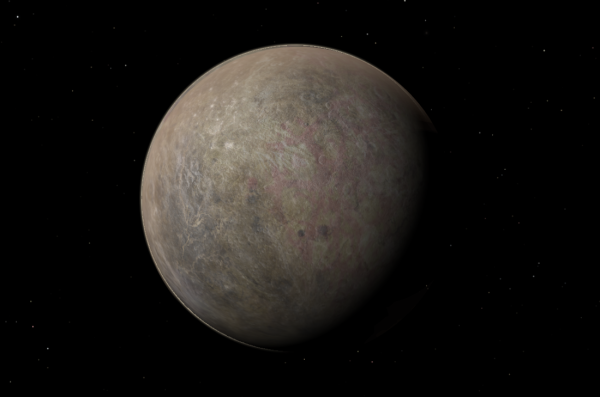 Image from Steve Bowers | |
| Olivine before colonisation, an Arean type planet. In the Current Era this world has been modified to resemble Old Mars more closely. | |
| Duminine System | Names: Duminine, 36 Ursae Majoris B, Gliese 394 (GJ 394), HD 237903 Physical characteristics: - Mass: 0.6580 x Sol - Radius: 0.6464 x Sol - Luminosity: 0.11 x Sol (bolometric) - Temperature: 4,100 Kelvin - Spectral type: K7 Ve - Age: 2.23 billion years System: 1) Namuyorok: Minervan. Semi-major axis = 0.261 AU, Orbital period = 63.62 days, Mass = 0.4 x Earth, Radius = 9580 KM 2) Satranadit: Arean Apnean. Semi-major axis = 0.428 AU, Orbital period = 133.6 days, Mass = 3.5 x Earth, Radius = 8770 km |
|---|
 Image from Steve Bowers | |
| The flag of New Mars is derived from the Old Mars flag, with two white stars on top to represent the new system. | |
| Reached | 1333 by Lagrange Defender survey probe Kochimotan. |
|---|---|
| Travel | Wormhole: The Remembrance of That Old Dream in Magenta (1,700 meter) to Aksijaha Beamlines: 6 Hazard rating: Most locations in the New Mars system have hazard rating of 0 to 1. Visa restrictions: Entry to member polities of the Dongkom Umbrella require a single shared visa which are granted at a seemingly random interval of time, while polities affiliated with the Metagovernment Order of New Mars have no unified visa restriction policy and generally differ greatly. The Khen Thu volume appears to grant visas based on willingness to adopt certain provided psychomods that promote and enforce behaviors seen as favorable within the community. |
System
The larger of the two stars, Maronyo, has a wide range of planets and megastructures, including two Arean (Mars-like) worlds.An artificial black hole suprashell world known as Glowing Flow, Glowing Sky had been constructed in the location where the planet Glowspeck used to be prior to its disassembly. The artificial planet, isolated from intense sunlight by a shell of PQDA, is entirely covered in fluids of various kinds, ranging from liquid rivers and flowing sands, to glaciers of substances with viscosities billions of times that of water. Many of the fluids contain microscopic luminescent particulates, allowing them to glow a specific color and light up the world's eternal darkness. Temporary relief features found on the more solid fluids are produced with help of the waste heat produced by the various processing cores utilized by a reclusive transapient community and their energy generators placed below the landforms, at the base of the suprashell. Closer to the black hole, field generators produce the planet's complex magnetosphere which redirects the incoming solar wind to random locations above the surface, producing complex patterns of aurorae.
The cooled and clarified atmosphere of Lem is currently dominated by a bubblehab supercontinent, not unlike one that used to drape Blanchard's skies, complete with a neogenic biosphere inspired by the one created on that world. The supercontinent coexists with water clouds hovering in the blue sky where the thick sulfuric acid cloud layer used to be; wispy sulfuric clouds continue to persist in the lower, more lightly developed altitudes where the temperatures remain sufficiently high for them.
A sunshield is positioned in front of Asukara, allowing only a fraction of the sunlight that used to shine upon it to pass through. Millennia of subsequent cooling has allowed the atmosphere to rain down to form a carbon dioxide ocean that is now bustling with neogenic marine organisms deliberately designed to resemble those from Ghanweng Psuto, an outer Middle Regions world that briefly became famous among the inhabitants of Asukara during the 8000s. Seasteads are a common sight on this world, as are low-flying airship habitats that can be found skimming the surface of the ocean or flying among the groups of sessile floaters and active flight organisms, although they rarely venture above the thick, hazy carbon dioxide cloud deck that almost entirely obscures any signs of life from outer space.
Eskarett is currently depopulated, for reasons not disclosed by the transapients of the New Mars system. Its surface, altered by mining operations from the early days and the once-bustling cities, is preserved in near perfect condition, unchanged for thousands of years. Eskarett is the location of the mysterious phenomenon known as the Untold Wandering (see Culture section, below).
Olivine and Rust, the outermost rocky planets of the Maronyo system, were both modified to resemble Mars in Solsys. Olivine's current surface environment is analogous to Mars prior to its colonization, with a thin carbon dioxide atmosphere at a pressure near water's triple point, permitting it to stay stable in the few low-lying areas where the temperature is high enough. No standing bodies of liquid water can be found on the surface in the Current Era however; most water on Olivine can be found either inside the many massive pressurized artificial caverns located several kilometers beneath the surface, or in the two vast, stable polar ice caps where carbon dioxide snow accumulates in winter. Habitats and cities, many of which have a superficial resemblance to the old Martian habitats from the early days of its colonization, dot its largely barren surface, while the carved ice tunnels and lively wet cavern networks serve as tourist spots.
 Image from Steve Bowers | |
| Before colonisation, the planet Rust was superficially similar to the planet Mars in the old Solar System. | |
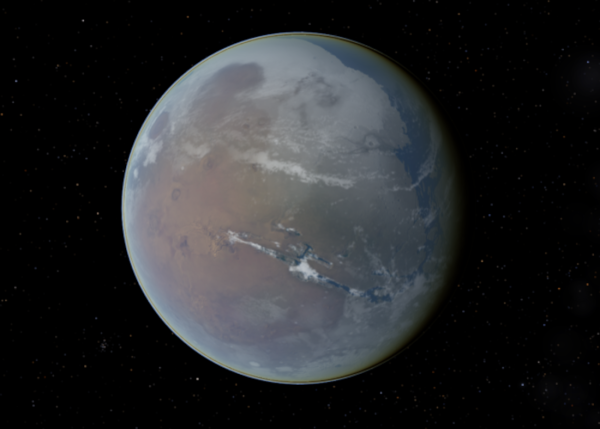 Image from The Astronomer | |
| In the Current Era, Rust has been enviroformed extensively to resemble the planet Mars as it exists nowadays, with shallow oceans and an oxygen-rich atmosphere. This involved the relocation of petatonnes of surface rock and the excavation of a replica of the Valles Marineris. | |
Surrounding the smaller of the two stars, Dunimine, is a volume known as the Khen Thu. This volume is home to tens of thousands of polities, commonly referred to as 'teams' and populated by a diverse assortment of sophonts united by their passion for ril-oriented activities that continuously contest with each other in a diverse range of sports against each other to claim new orbits around the star and generally expand their presence.
Politics
The two stars of New Mars are dominated by different organizations. Most polities around Maronyo, beyond the star's immediate surroundings, are members of the Metagovernment Order of New Mars, a Terragen Federation-aligned suprapolitical entity that formed during the Version War. The polities around Duminine are generally aligned with the Dongkom Umbrella, a neutral minor interstellar organization with members drawn from a handful of star systems scattered across the Nexus. An increasing number of polities have begun rejecting membership in either of these entities over the last thousand years, possibly marking the system's transition into a new political era.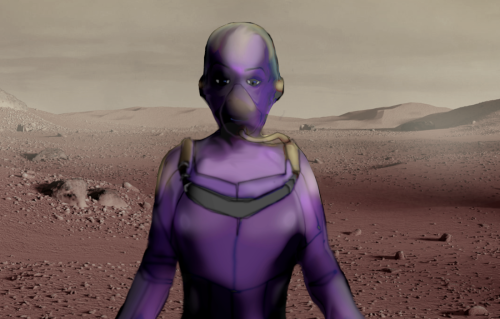 Image from Steve Bowers | |
| A small but influential population of Mars-adapted tweaks have migrated to the New Mars system, and mostly live on Olivine and Rust | |
Culture
Today New Mars is one of the most populous systems, with over 20 billion inhabitants. A population of tweaked sophonts resembling the Interplanetary Age tweaks of Mars have chosen to live on Olivine and Rust, and their numbers are swelled by modosophonts of many origins who have chosen to adopt this bodymorph on a temporary or permanent basis. These tweaks are a minority, although they are influential and have a venerable culture.The Dunimine system with its two small planets is home to the Khen Thu culture, a polity under the guardianship of the S2 hivemind Upholder of Sportsmanship, an affiliate of the NoCoZo. Khen Thu retains NoCoZo influence even in the Current Era, but is different in many ways to the original culture established when New Mars was first colonised.
The mysterious Untold Wandering phenomenon on Eskarett attracts a great deal of interest. Visitors to this largely deserted world may occasionally be picked by an unknown (but likely transapient) agent, and transported to a random location on the planetary surface, where they spend a certain period of time - ranging from a few hours to decades - only to be returned to their previous location at the end of the experience with no physical change to their condition. However this experience is often accompanied by profound feelings of wellbeing and enlightenment. Many journey to Eskarett from all over the New Mars system, as well as from the Sophic League and other religious polities, hoping to be chosen for the experience. The Untold Wandering is (perhaps surprisingly) viewed quite positively within the New Mars system, and is referenced quite often in various fictions related to New Mars.
New Mars attracts a lot of tourists, especially those with actual or imagined links to the Old Martian system. Many come to visit the childhood home of Killavan Yu-Tang, the astronomer and explorer, on Olivine.
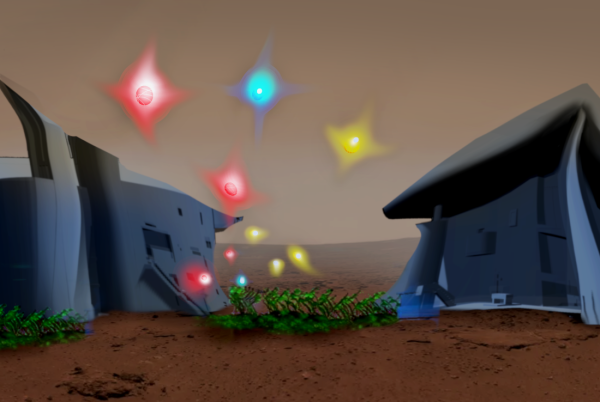 Image from Steve Bowers | |
| A group of Polariser vec tourists float above the surface of Olivine | |
Related Articles
Appears in Topics
Development Notes
Text by The Astronomer
from an original article with material by Anders Sandberg and Steve Bowers
Initially published on 09 December 2001.
References
Star A
- https://www.aanda.org/articles/aa/full_html/2022/01/aa41763-21/aa41763-21.html (Mass = 1.049 Sol, radius = 1.180 Sol, temperature = 6102 K)
- https://iopscience.iop.org/article/10.3847/1538-4357/ab66c7 (Mass = 1.08 Sol, age = 2.23 Gyr)
- https://iopscience.iop.org/article/10.3847/1538-4357/ab9a35 (Age = 3.460 Gyr)
- https://arxiv.org/abs/1305.0155 (Mass = 1.119 Sol, radius = 1.091 Sol, temperature = 6233 K, luminosity = 1.605 Sol, age = 1.5 Gyr)
Star B
- https://simbad.cds.unistra.fr/simbad/sim-id?Ident=TYC+3819-1043-1 (Mass = 0.6580 Sol, radius = 0.6464 Sol, surface gravity = 10^(5.0-2), temperature = 4100 K, luminosity = 0.1063649500 Sol)
from an original article with material by Anders Sandberg and Steve Bowers
Initially published on 09 December 2001.
References
Star A
- https://www.aanda.org/articles/aa/full_html/2022/01/aa41763-21/aa41763-21.html (Mass = 1.049 Sol, radius = 1.180 Sol, temperature = 6102 K)
- https://iopscience.iop.org/article/10.3847/1538-4357/ab66c7 (Mass = 1.08 Sol, age = 2.23 Gyr)
- https://iopscience.iop.org/article/10.3847/1538-4357/ab9a35 (Age = 3.460 Gyr)
- 36 UMa 10 30 37.58 +55 58 49.94 F8V 0.532 -4.728 3 828. 1860. 3460. 6690 11400 828. 1860. 3460. 6690. 11400.
- https://arxiv.org/abs/1305.0155 (Mass = 1.119 Sol, radius = 1.091 Sol, temperature = 6233 K, luminosity = 1.605 Sol, age = 1.5 Gyr)
Star B
- https://simbad.cds.unistra.fr/simbad/sim-id?Ident=TYC+3819-1043-1 (Mass = 0.6580 Sol, radius = 0.6464 Sol, surface gravity = 10^(5.0-2), temperature = 4100 K, luminosity = 0.1063649500 Sol)






